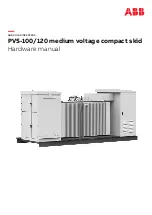
Chapter 6 Troubleshooting
121
Ch
ap
ter 6
No. Fault ID
Failure type
Possible causes
Solutions
identified
43 Err.43
Motor over
speed fault
1.the parameter was not
identified
2.the setting for encoder
parameters is incorrect
3.the setting for motor
overspeed detection
parameter(F8.13, F8.14) is
unreasonable.
1.perform identification for the
motor parameters
2.correctly set encoder
parameters
3.reasonably set the detection
parameters
45 Err.45
Motor
overtemperat
ure fault
1.the wiring of temperature
sensor is loose
2.the motor temperature is too
high
1.detect the wiring of
temperature sensor wiring and
eliminate fault.
2.decrease carrier frequency or
take other cooling measures to
cool motor
51 Err.51
Initial
position error
the deviation between the
motor parameters and the
actual parameters is too large
reconfirm the correct motor
parameters, focus on whether the
rated current is set to too small.
-
COF
Communicati
on failure
1.Keyboard interface control
board interface
;
2.Keyboard or crystal
connector
;
3.Control board or keyboard
hardware damage
;
4.Keyboard line is too long,
causing the interference.
1
.
Detection of keyboard
interface, control board interface
is abnorma.
2.Detect keyboard, crystal joints
are abnormal.
3.Replace control board or
keyboard.
4. Consult factory, seek help.
6-2.EMC (Electromagnetic Compatibility)
6-2-1.Definition
Electromagnetic compatibility refers to the ability that the electric equipment runs in an
electromagnetic interference environment and implements its function stably without interferences on
the electromagnetic environment.
6-2-2.EMC standard
In accordance with the requirements of the Chinese national standard GB/T12668.3, the inverter
must comply with the requirements of electromagnetic interference and anti- electromagnetic
interference.
Our existing products adopt the latest international standards: IEC/EN61800-3: 2004 (Adjustable
speed electrical Power drive systems Part 3: EMC requirements and specific test methods), which is
equivalent to the Chinese national standards GB/T12668.3. EC/EN61800-3 assesses the inverter in
terms of electromagnetic interference and anti-electronic interference. Electromagnetic interference
mainly tests the radiation interference, conduction interference and harmonics interference on the
inverter (necessary for civil inverter).
Anti-electromagnetic interference mainly tests the conduction immunity, radiation immunity,
surge immunity, EFTB(Electrical Fast Transient Burs) immunity, ESD immunity and power low
frequency end immunity (the specific test items includes: 1. Immunity tests of input voltage sag,
interrupt and change; 2.commutation notch immunity; 3. harmonic input immunity ; 4. input
frequency change; 5. input voltage unbalance; 6. input voltage fluctuation). The tests shall be
conducted strictly in accordance with the above requirements of IEC/EN61800-3, and our products
are installed and used according to the guideline of the Section 7.3 and can provide good
electromagnetic compatibility in general industry environment.
6-3.EMC directive
















































